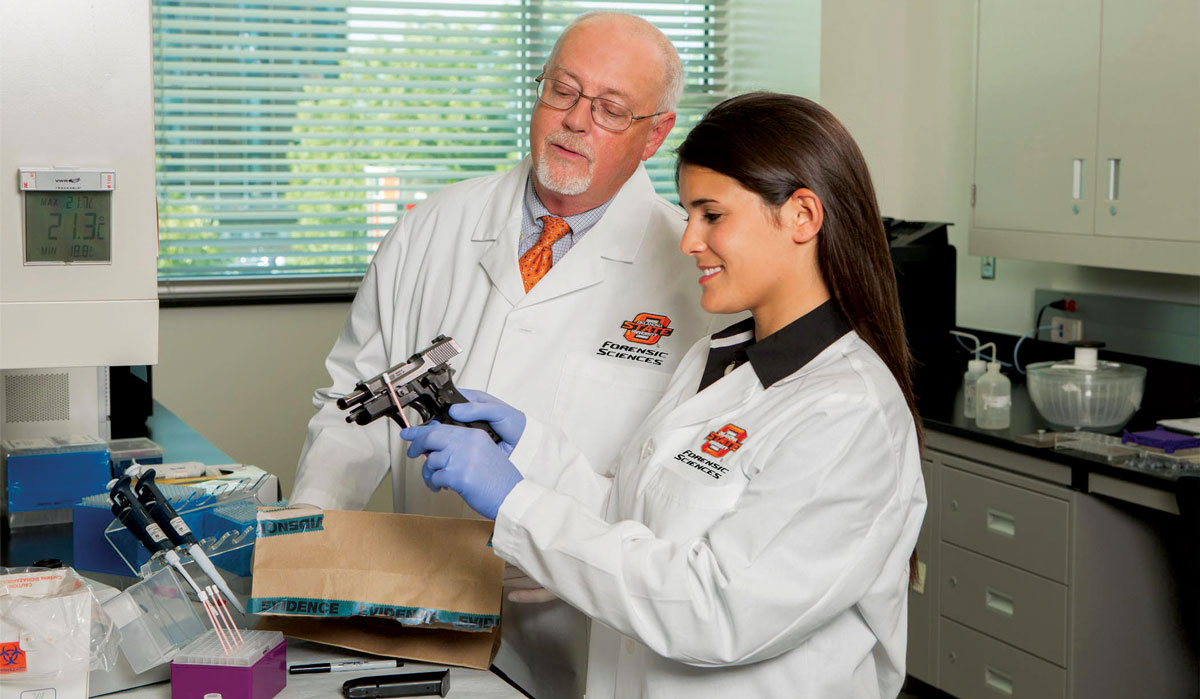Swabbing for Clues
Monday, November 9, 2015

A simple device developed by forensic sciences researchers at OSU Center for Health Sciences in Tulsa could help law enforcement investigators identify suspects in thousands of unsolved crimes.
“Whenever a person touches a surface or object, they leave small flakes of skin or other biological material behind,” says Robert Allen, head of the School of Forensic Sciences at OSU-CHS. “The device we developed will enable crime scene investigators to better collect all of that material for DNA testing.”
The Power Swab uses a glass-infused fiber to collect the genetic material.
“Using glass is part of the standard DNA extraction methodology — DNA binds tightly to glass when mixed with a high-salt solution,” says Allen. “But nobody has tried using glass as part of the swab to gather evidence at the crime scene before.”
The School of Forensic Sciences offers advanced training for law enforcement investigators and laboratory technicians in several areas, including crime scene investigation and DNA analysis. The Power Swab project was a perfect combination of those two core areas.
“The research conducted by Dr. Allen and other researchers in the School of Forensic Sciences is focused on making the world a safer place,” says Dr. Kayse Shrum, president of OSU- CHS. “The techniques our scientists are creating to help properly identify suspects will assist with prosecutions and could ultimately remove more criminals from the streets.”
When working with such tiny amounts of evidence (such as a few skin flakes, saliva or a drop of blood), it is critical to collect as much of the biological material as possible to create a complete DNA profile.
Previous research Allen had conducted showed that the amount of trace DNA left at a crime scene varies based on genetics, gender, hygiene and other factors. This variability is another factor that makes it important to collect all the DNA evidence a suspect leaves behind.
“Investigators have used several different means to collect trace DNA, like tape, but the effectiveness varied,” says Allen. “Some labs avoid working with trace DNA because it is so difficult to get a complete DNA profile. We hope that changes with these swabs.”
Allen believes the swabs could prove useful for investigations of robberies, improvised explosive devices and other crimes where the only evidence of the suspect might be trace DNA.
“We really think the Power Swab will have a major impact on the investigations of these types of crimes,” he says. “By collecting all the DNA at a crime scene, we should be able to increase the percentage of cases that have a complete DNA profile.”
Those profiles can be entered in the national DNA database to see if they match with any known offenders. If the sample does not match, it will create a criminal profile in the event the suspect commits any other crimes.
The concept for the Power Swab originated when a graduate student, Rachel Powers, needed a project to work on as part of her graduate degree program. Allen thought the project might produce some positive results since glass is commonly used in DNA extractions.
“The knowledge about the relationship between glass and DNA has been around since the 1970s, but we are the first to put that concept to use with a swab in the field,” says Allen.
OSU has applied for a patent and is in the process of partnering with a swab manufacturer to produce prototypes for testing in the field. Allen has contacted the U.S. Army Criminal Investigation Laboratory and entered into discussions about field-testing the Power Swabs.
“The Power Swab is an accessory for crime scene investigators that will make DNA analysis technology more dependable,” says Allen. “Field testing will enable us to see how it works for the investigators who will use it every day.”
